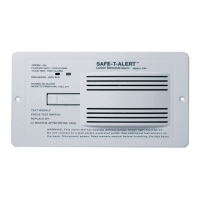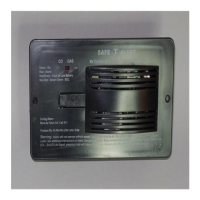RECREATIONAL VEHICLE (RV)
Carbon Monoxide Alarm
USER’S MANUAL
65 Series Surface Mount Models:
65-541, 65-541-R, 65-541-MS, 65-541-R-MS
65 Series Flush / Recess Mount Models:
65-542, 65-542-R, 65-542-MS, 65-542-R-MS
ALL RIGHTS RESERVED 65RV120810-6
ATTENTION: This user’s manual contains important Carbon
Monoxide (CO) alarm installation, operation, troubleshooting and
warranty information. Read, follow, and keep this manual for future
reference.
NOTE: If you install or purchase this alarm for another person, give
this manual to that person.
IMPORTANT: This unit must be replaced within five years of its
installation date. This unit has an End of Life (EOL) signal that will
sound after 5 years of use. Record the installation date in the section,
Owner’s Replacement Record, in this manual for future use. The
replacement date indicates the date beyond which the device may no
longer detect carbon monoxide, The device should be replaced.
The electronic CO sensor in your SAFE-T-ALERT
TM
CO alarm is
very sensitive to CO gas. It will not react to most other gases.
WHY EVERY RV NEEDS A 65 SERIES CO
ALARM
Everyone is at risk for carbon monoxide poisoning! Particularly sensitive are
children, pregnant women, the elderly and people with lung or heart disease or
anemia! Carbon monoxide (CO) is an odorless, colorless gas that prevents the
blood from carrying oxygen to vital organs. CO is 200 times more likely to
replace oxygen in the blood. The Consumer Product Safety Commission
(CPSC) recommends using at least one CO alarm located outside of
sleeping areas. For the extra security, locate additional CO alarms in each
sleeping area.
ABOUT THIS ALARM
Because CO is a colorless, odorless, tasteless and highly poisonous gas; it
can endanger lives even at low levels of concentration. The CO Alarm
will alert you to potentially dangerous situations. The following
symptoms may be related to CO POISONING. Discuss these
symptoms with ALL household members and RV guests:
Mild Exposure: Headaches, running nose, sore or watery eyes, often
described as “flu-like” symptoms.
Medium Exposure: Dizziness, drowsiness, vomiting.
Extreme Exposure: Unconsciousness, brain damage and death.
NOTE: Reported cases of CO gas poisoning indicate that while
victims are aware they are not well, they are disoriented. They are unable
to save themselves by exiting the RV or calling for
assistance. Small children and pets may be affected first.
Your SAFE-T-ALERT
TM
Series alarm helps protect your family
members and guests from CO produced while using your RV. CO gas is
produced when any type of fuel is incompletely burned. Potential sources
of CO in and around your RV can include gas or diesel engine exhaust,
portable space heaters, gas stoves and ovens, furnaces, defective engine
exhaust systems, charcoal, portable grills, other nearby RVs, portable
generators, generator exhaust, and other propane-powered appliances. All
are sources of CO.
The following are also sources of CO that may affect your RV:
Extended operation of unvented fuel burning appliances can build up
high CO levels.
An idling vehicle in an open or closed garage.
Temperature inversions can trap exhaust near the ground.
CO build up can be caused by reverse/negative venting of fuel burning
appliances including; 1) Clogged, loose or faulty stacks or chimneys of
(clothes dryers, furnaces and water heaters, etc.), 2) wind direction
and/or velocity, 3) simultaneous operation of multiple fuel burning
appliances, and/or exhaust fans.
WARNING:
LIMITATIONS OF CO ALARMS
THIS ALARM WILL NOT WORK WITHOUT POWER. Some
reasons for no alarm power; are a blown or missing fuse, broken wire, a
faulty wire connection or circuit breaker, a discharged battery, cut lead
wires, or improper supply (+) or ground (-) connections.
THIS ALARM WILL ONLY INDICATE THE PRESENCE OF GAS
AT THE SENSOR. CO may be present in other areas. MTI recommends
installing CO alarms in all sleeping areas. Do not block or cover the
alarm with any object that can prevent carbon monoxide from
reaching the sensor.
THIS ALARM IS INTENDED FOR USE IN RV's. It is intended for
use inside the RV. It is not designed to measure compliance with
commercial and industrial standards.
THIS ALARM MAY NOT BE HEARD. The alarm’s loudness is
designed to meet or exceed regulatory standards; however, the alarm may
not be heard if alarms are located in remote locations or behind closed
doors. Persons who are hard-of-hearing, have consumed alcoholic
beverages, taken prescription, non-prescription or illegal drugs, may not
hear the alarm.
THIS ALARM IS DESIGNED TO DETECT CARBON MONOXIDE.
THE ALARM IS NOT DESIGNED TO DETECT SMOKE, OR FIRE.
THIS ALARM MAY NOT ALARM AT LOW CO LEVELS It is not
designed to measure compliance with the Occupational Safety Health
Administration (OSHA) commercial or industrial standards. Individuals
with medical problems may consider using warning devices, which provide
audible and visual signals for CO concentrations under 30 ppm.
HOW TO PROTECT YOUR FAMILY
CAUTION- The SAFE-T-ALERT
TM
65 Series combination CO Alarm
is designed to protect individuals from the acute effects of carbon
monoxide exposure . It will not fully safeguard individuals with specific
medical conditions. If in doubt, consult a medical practitioner.



